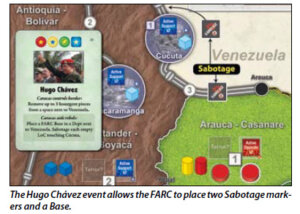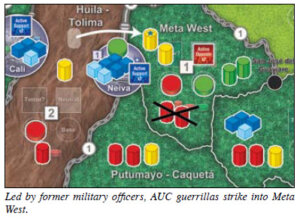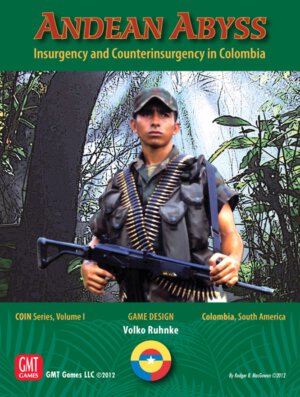Publisher: GMT Games
Designer: Volko Ruhnke
Artists: Xavier Carrascosa, Charles Kibler, Rodger B. MacGowan, Chechu Nieto, and Mark Simonitch
Year: 2012
Genre: Card driven game of military, political, and economic conflict
Players: One to four players
Ages: 14+ (Just my estimation)
Playing Time: 90 minutes and up
MSRP: $75.00
Andean Abyss is the latest design from Volko Ruhnke (Labyrinth: The War on Terror) and is the first in GMT’s COIN series; COIN represents Insurgency and Counter Insurgency conflicts. The game allows for one to four players to take on the leadership of any of four factions looking to control Colombian affairs during the 1990s and early 2000s. The factions pitted against each other are the Colombian Government, the Marxist FARC, the right wing “paramilitaries” of the AUC, and the drug trafficking Cartels. Each faction will exploit events as well as use military, political, and economic actions in order to achieve their faction aims and gain victory.
Upon cracking open the box we find two booklets, one for the rules (16 pages) and another playbook (44 pages) which includes a detailed tutorial, designer notes, card descriptions, and many other sections to help ease play. I’ll point out it’s imperative to give the playbook a solid read through as this is essential to understanding all of the elements of play in this extremely interesting, possibly initially confusing, simulation of the volatile political situation of Colombia in the late 20th and early 21st centuries. Just as in Labyrinth, Ruhnke has brought many design wrinkles to Andean Abyss and you’ll be best served to study the rules and playbook in a little more detail than you may normally devote in order to get the most out of the game.
As this is a GMT release, I don’t think I have to go through a complete run down of each and every component except to say we get to enjoy the same level of exceptional quality as we’ve come to expect from one of GMT’s spotlight releases; the map is mounted and nicely laid out (if possibly a touch cluttered), the cards are good stock, and all the wooden pieces of varying shapes and sizes are nicely done. All in all, yet more of the GMT goodness we know and love.

The map of Colombia shows the country itself as well as some of its neighbors, who may come into play based on events, and is broken down into departments. Each department will show a population value as well as the type of terrain encompassing the area: tropical forest, grassland, or mountains. Each point of population represents approximately one million Colombians. Departments also include boxes which represent bases the differing factions may be able to utilize in the area such well as providing an indicator of support and opposition for the Colombian Government. Cities are also represented on the map and are separate from departments; i.e. a city does not reside in a department but is a completely unique location. These cities can hold anywhere from one to eight million citizens. Lines of communication are also represented (roads and pipelines) and these also carry an economic value of anywhere from one to three which effect Government resources. Pipelines tend to carry higher Econ values and can be affected by various events. All of these areas can hold forces on the map.
Once each player has set up their forces, as indicated on the board, the event card deck is shuffled and the first card is drawn and placed onto the map to indicate this is the active card. A second card is also revealed and placed on top of the deck to show that this will be the next card to come into play. This means all players get to see one card ahead so they can plan accordingly. At the top of the played card is a row of symbols indicating each faction and the turn order for that card. An example would be the order of the Government, FARC, Cartels, and AUC. Everyone starts the game eligible to perform an action (an operation) or activate the event. Each turn only two factions will be able to do this. So, using the turn order of the aforementioned card, the Government player may choose to initiate the event, perform an operation – with or without a special ability, or choose to pass and thus collect resources. Depending on what the first player chooses to do the second faction may then follow with a limited operation, activating the event if it is still available, execute an operation with or without those special abilities, or pass. If either of the first two factions chose to pass, the third faction is able to step in and do something. This can seem a bit confusing as following players find their options are limited by what the previous players choose to do. Thankfully, the sequence is on everyone’s player aid card so after a few turns you come to grips with the procedure.

Each faction has a variety of operations it may choose to initiate, as well as accompanying special abilities, if an operation is chosen. For the most part the three insurgent factions have similar operations such as Rally, March, Attack, and Terror. Where these differ is the special abilities which can also be added to the operation such as kidnappings, assassinations, bribery, and so on; each insurgent plays quite differently. The Government, on the other hand, may train forces, place those forces on patrol, sweep areas, and assault. Special abilities such as air lifts, air strikes, and eradicating drug cartel bases may also come into play. Operations cost resource points so everyone has to juggle managing resources as well. The Cartels especially need to build resources as that’s one of their victory conditions.
All factions have limitations to the number of forces and bases which can be on the board at any one time, even if you have the resources available to recruit or build.

In general terms the Government wins with overwhelming support from the people, the FARC wins if they can raise enough opposition as well as possess enough bases, the AUC wins if they have more bases than FARC, and the drug Cartels win if they have enough bases and a large number of resources. Everyone knows what each faction needs to win, so crafty players will divide their time working on attaining their own victory while doing their best to prevent their opponents from doing the same for themselves. This can lead to a few turns where three players focus attention on bringing the lead player back to the pack by knocking them down a peg or two, so to speak.
For the sake of brevity, I’m not including each and every aspect of the game as there are a lot of small details which add to the overall experience but don’t require minute description for review. Presidential elections, drug shipments, player negotiations and more take place and suffice to say these provide a bit more meat to the game. There’s a lot cooking and just a casual glance, or cursory play through, can’t bring all Andean Abyss has to offer to the surface.
Overall, Andean Abyss is an excellent game, although there are some items which need to be pointed out for folks wanting to give the title a shot. First is the look of the game itself. As we’ve seen in some previous designs released from GMT, there’s a bit of the look of a Euro style game especially with various wooden pieces representing forces and markers. Suffice to say this certainly isn’t a Euro by any stretch (or at least in my book) so gamers seeing the components and thinking this is just a deeper style Euro should take heed. On the flipside, this can’t specifically be coined a wargame either – although there’s plenty of conflict taking place – as a very abstract approach to combat is utilized. Andean Abyss is truly a simulation of the military, political, and economic conditions four widely different ideological opponents faced for more than a decade in Colombia as each struggled for overarching power.

Lastly, and this is surely no knock on the design, I’m not sure about the appeal of the subject matter. I can certainly say by playing Andean Abyss I learned loads about what was going on in Colombia during the period – even for someone who’s read a few books about the drug wars in the region – yet I can’t say the topic is one which gamers are clamoring to get their hooks into. On the other hand, it’s not as if we really need another game on the Battle of the Bulge so I for one welcome something which is a radical departure from the same old same old.
At the end of the day what’s my verdict on Andean Abyss? I have to say it’s an excellent new addition to Volko Ruhnke’s growing resume and certainly one of the most impressive games of the year. It’s important to note this isn’t a game for everyone nor, I’d take a stab, was it designed to be so. This is a title perfectly suited for gamers who enjoy a deep game which demands playing a number of times before nuances in strategy begin to take shape. As I previously mentioned, it’s crucial to dive into that playbook to better understand the systems and how they integrate into the game; simply kicking the tires and jumping right in will no doubt lead to disappointment for all involved. People who are looking for a quick sixty minute, four player game in which to kick it with beers – without focusing too heavily on play – should no doubt take a pass in my opinion. Yet for those out there who love to delve into a solid experience, which may involve a bit of mental heavy lifting (with or without beers), owe it to themselves to pick up Andean Abyss! The game itself is a truly engrossing experience – once you have a handle on the rules – and provides excellent narrative from each play.
[rwp-review id=”0″]
- Castles & Crusades: Players Handbook Reforged Edition Reviewed - Apr 7, 2025
- Campaign Builder: Dungeons & Ruins Reviewed - Apr 5, 2025
- Space 1999: The Roleplaying Game Receives a Free Quickstart - Apr 4, 2025




















Thanks for another excellent review. I passed on preordering this, but I may have to pick it up during GMTs fall sale. Especially, since the upcoming A Distant Plain looks really interesting.
I can’t say how well Andean Abyss plays solo, or with fewer than the full four players, but I found it to be a really interesting design and not like anything out there – even Labyrinth really – so it’s definitely a good pick up. I’m right with you about A Distant Plain, as I believe the subject matter will be a bit more to the American game buyer. Unfortunately, at this moment the title is just shy of hitting the P500 numbers to go to print.
I’m a colombian that just discovered the existence of this game, and not a traditional wargamer, so i can’t comment much on the mechanics themselves. Instead i’ll comment on the background.
It’s, to say the least, chilling. From what i’ve read so far, it’s been impressingly well researched. It’s both fascinating and disturbing to see the news you’ve read and watched on TV and newspapers for years turned into a game. It’s also fascinatingly morbid to see action cards with dead people, knowing it came from a news source, and that those people died in exactly the way described in there just a few years ago.
All in all, i’ll give it a tentative vouch of approval on it’s research and background, with the caveat that the conflict is not over, as tentatively implied on the background, but still ongoing, has been ongoing for decades now, and with no signs of an end in sight.
I’d love to know what you think of the title as a game, if you’ve had a chance to play it Jamie. I can certainly appreciate the strange feeling one might get playing something which recreates events someone personally lived through. From speaking with a few people from Colombia over the years I understand the battle over the soul of the country continues to this day and I’m thankful I haven’t had to face the same struggles Colombians face on a daily basis.
Really nice job, Jeff – this game is a big-time winner, and hopefully it will be the herald for a new featured game series from GMT. I haven’t been this excited for a series since ‘States of Siege’ (and we know how well that worked out)!
I’ve enjoyed the heck out of AA 2-player (with no bots) – each side takes two factions (AUC/Gov’t and Cartels/FARC), which opens up some really interesting synergy and decision-making situations during play.
Solitaire is excellent (even without the bots), especially when learning the game.
Funny, the Colombian topic had very little interest for me prior, but now I can’t get enough of it – just a fascinating (and often tragic) time in South American history.
FYI, AA will be featured in next issue of C3i magazine (Decemeber, 2012) – check out the GMT website for details.
Thnx again for the fine review, and I agree with your salient points. Good job, sir.